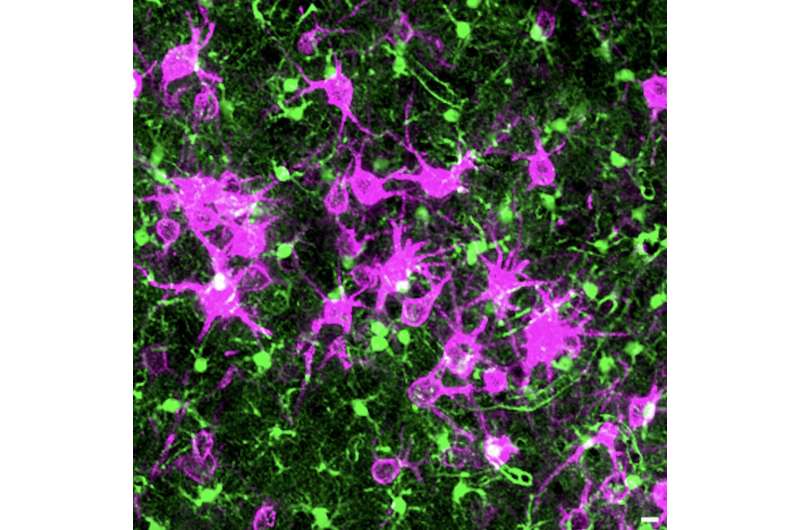July 31, 2024 feature
This article has been reviewed according to Science X's editorial process and policies. Editors have highlighted the following attributes while ensuring the content's credibility:
fact-checked
peer-reviewed publication
trusted source
proofread
How astrocytes and perineuronal nets cooperate to sustain synaptic homeostasis

Synapses are small gaps between neurons through which signals are transmitted. This transmission of signals is what allows neurons to communicate and ultimately produce complex internal processes, such as thoughts and feelings, as well as actions and behaviors.
The loss or deterioration of synapses is typically accompanied by a decline in brain function and cognitive impairments, such as those observed in patients diagnosed with Alzheimer's disease, Parkinson's disease and other neurodegenerative disorders. Better understanding the neural processes that ensure the stability and function of synapses could thus inform the development of more effective therapeutic interventions for these disorders.
Researchers at University of Virginia School of Medicine recently carried out a study investigating the combined role of astrocytes, a class of glial cells with many known neuroprotective functions, and perineuronal nets (PNNs), structures that form a coating around some neurons, in regulating synaptic activity over time. Their findings, published in Nature Neuroscience, show that astrocytes and PPNs cooperate to maintain synaptic homeostasis in the mouse brain.
"My laboratory has been studying brain support cells called astrocytes for the past 30 years," Harald Sontheimer, senior author of the paper and Harrison Distinguished Professor at University of Virginia, told MedicalXpress. "Astrocytes serve many functions in the brain but one of the most important ones is the removal of the neurotransmitter glutamate."
Glutamate is the primary neurotransmitter that nerve cells in the brain use to communicate with one another. Past neuroscience studies showed that astrocytes surround synapses, ensuring that glutamate remains at each synapse, without spilling over onto nearby synapses.
"Over 125 years ago, Camillo Golgi discovered a net-like structure of extracellular molecules that covers the surface of some neurons," Sontheimer said. "He called these structures perineuronal nets (PNNs), albeit he and many scientists since have not been able to figure out what these structures do. In the 1970s, it was discovered that they are important in brain development when they ensure that certain synapses between cells of the sensory system stay in place once they are formed."
Previous studies have concluded that PNNs play a key role in stabilizing synapses over time, yet they failed to examine their possible link to astrocyte activity. Given their interest in astrocytes and their role in regulating synapses, Sontheimer and his colleagues set out to investigate whether astrocytes are related to PNNs and specifically if they are also stabilized by these structures.
"PNNs are constantly turned over in the healthy brain," Sontheimer said. "In other words, neurons synthesize them and enzymes produced by neurons and support cells degrade them. PNNs are also degraded by a bacterial enzyme called Chondroitinase ABC. In our first experiments, we took this enzyme and injected it into the brains of mice, and within 40 minutes the PNNs disappeared."
By degrading PNNs using the enzyme Chondroitinase ABC, the researchers were able to observe how damage to these structures impacted synapses and astrocytes, Interestingly, they found that synapses remained in place, while astrocytes extended their processes, covering all the membrane laid bare after the removal of PNNs.
"These experiments also allowed us to study what happens functionally to such synapses after PNNs were removed," Sontheimer explained. "Much to our surprise, we found that glutamate now spilled out of them and activated receptors far away, thereby compromising the signaling between adjacent nerve cells."
Sontheimer and his colleagues observed that after PNNs had degraded, the adult mice started experiencing epileptic seizures. This suggests that the net-like structures act as containers that prevent the dispersion of glutamate from synapses, thus ensuring that astrocytes dispose of the neurotransmitter before it can activate neighboring nerve cells.
"Our findings suggest that the function of synapses can be affected by enzymes that are released in conjunction with tissue inflammation and disease," Sontheimer said. "We show that in a mouse model of Alzheimer's disease, and in epilepsy, enzymes released break down the PNNs and alter neuronal signaling, even causing seizures."
The results gathered by this team of researchers offer new valuable insight into the unique contributions of PNNs and astrocytes to synaptic homeostasis. In addition to inspiring further studies focusing on the neural processes they uncovered, they could pave the way for the development of new therapeutic interventions, such as enzyme inhibitors that prevent the breakdown of PNNs in patients diagnosed with Alzheimer's or epilepsy.
"We are now trying to understand how the loss of PNNs comes about at the cellular level, as well as how and when it is best to prevent it," Sontheimer added.
More information: Bhanu P. Tewari et al, Astrocytes require perineuronal nets to maintain synaptic homeostasis in mice, Nature Neuroscience (2024). DOI: 10.1038/s41593-024-01714-3
© 2024 Science X Network





















